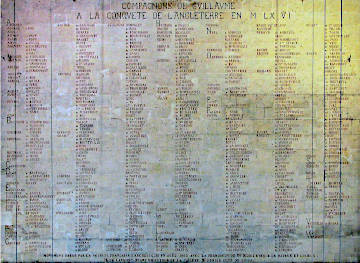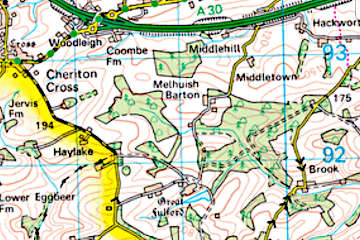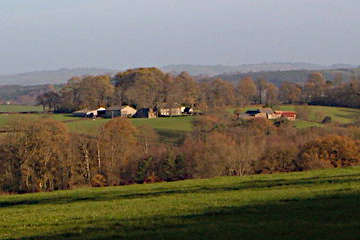Melhuish Manor
Melhuish is a toponymic surname, meaning it derives from a certain place. In our case that is Melhuish Manor, now Melhuish Barton, near Tedburn St Mary in Devon.
 The village of Melhuish is recorded in the Domesday Book. The original entry is inevitably pretty incomprehensible, being written in Latin and packed with abbreviations. The Phillimore translation into English is still pretty blunt:
The village of Melhuish is recorded in the Domesday Book. The original entry is inevitably pretty incomprehensible, being written in Latin and packed with abbreviations. The Phillimore translation into English is still pretty blunt:
Hugh [of Rennes] holds MELHUISH from Baldwin. Brictmer held it before 1066.
It paid tax for 1/2 hide. Land for 7 ploughs; as many there, with 4 slaves and 8 villagers and 4 smallholders.
Meadow, 3 acres; pasture, 15 acres; woodland, 24 acres.
6 cattle; 24 goats.
Formerly 20s; value now 30s.
Land of Baldwin the sheriff.
An alternative rendering of the Domesday entry comes from the Victoria County History of Devon:
Baldwin de Brionne has a manor called Melewis which Brismer held on the day on which King Edward was alive and dead January 5th. 1066, and it paid geld for ½ hide. This 7 ploughs can till, Hugh of Rennes holds it of Baldwin, Thereof Hugh has in demesne 1 virgate and 1 plough, and the villeins 1 virgate and 6 ploughs.
There Hugh has 8 villeins, 4 bordars, 4 serfs, 6 beasts, 24 goats, 24 acres of woodland, 3 acres of meadow, and 15 acres of pasture, worth 30/-a year; when Baldwin received it, it was worth 20/-. The area of the whole manor was about 120 acres.
Open Domesday (which is a fantastic resource for anything about the Domesday Book) explains the content of the Domesday entry in a similar manner:
The lord of the manor was Hugh of Rennes (more of him below) and his lord in turn was Baldwin, the Sheriff of Devonshire, who was the tenant-in-chief who held the land directly from the king.
In 1066 the lord of the manor was Brictmer, presumably an Anglo-Saxon who was dispossessed after the Norman Conquest.
The other occupants were 8 villagers, 4 smallholders and 4 slaves. (Women and children were not counted.)
There were 7 ploughlands, 1 for the lord's plough teams and 6 for the villagers. A ploughland is said to be the land that could be ploughed by 8-oxen teams in the course of a year so could be quite extensive, as much as 120 acres. Meadow, pasture and woodland are self-explanatory.
Livestock were just 6 cattle and 24 goats. There is no mention of the oxen required for ploughing.
The value to the lord was now 30 shillings, having been just 20 shillings when he first acquired the manor.
 Hugh of Rennes (Hugo de Rennes) was one of the knights who came over to England with William the Conqueror. Melhuish Manor (and his other two manors in Devon) would have been his reward for service. There is a plaque in the church at Dives-sur-Mer in Normandy from where William set sail for his invasion of England. The plaque lists all the knights who took part, including Hugue de Rennes.
Hugh of Rennes (Hugo de Rennes) was one of the knights who came over to England with William the Conqueror. Melhuish Manor (and his other two manors in Devon) would have been his reward for service. There is a plaque in the church at Dives-sur-Mer in Normandy from where William set sail for his invasion of England. The plaque lists all the knights who took part, including Hugue de Rennes.
In accordance with the convention of the time Hugh was "de Rennes" because that was where he originally came from. His successors would have been "de Melewis", or whichever spelling they chose to use at the time. Hence we find in various ancient documents William de Melehywis, John de Melewis, Elinora de Melhyws and John de Melhuwysshe.
 Fast forward now to the fifteenth century where we find William de Melhuwysshe siezed of the manor of Melhuwysshe. His son was John, but John had just daughters: Thomasia, Matilda and Joan. According to The Genealogist Volume 18 Page 34 "the three co-heiresses had enfeoffed Henry Fuleford father of Baldwin Fuleford of Great Fulford." The technicalities of what this meant is a bit woolly and I would welcome any help in understanding this better. However the practical result appears to be that Melhuish Manor became Melhuish Barton, a farm incorporated within Great Fulford Manor. Melhuish Barton is named on the 1:50,000 Ordnance Survey maps and so far as I know is still a part of Great Fulford. Perhaps this is how "Fulford" became "Great Fulford".
Fast forward now to the fifteenth century where we find William de Melhuwysshe siezed of the manor of Melhuwysshe. His son was John, but John had just daughters: Thomasia, Matilda and Joan. According to The Genealogist Volume 18 Page 34 "the three co-heiresses had enfeoffed Henry Fuleford father of Baldwin Fuleford of Great Fulford." The technicalities of what this meant is a bit woolly and I would welcome any help in understanding this better. However the practical result appears to be that Melhuish Manor became Melhuish Barton, a farm incorporated within Great Fulford Manor. Melhuish Barton is named on the 1:50,000 Ordnance Survey maps and so far as I know is still a part of Great Fulford. Perhaps this is how "Fulford" became "Great Fulford".
 Given the three Melhuwysshe daughters all married and would have taken their husband's surnames, we can conclude that no modern Melhuishes are descended from John, Thomasia, Matilda or Joan. We must instead be descended from sons of earlier lords of the manor who moved away and established themselves in other parts.
Given the three Melhuwysshe daughters all married and would have taken their husband's surnames, we can conclude that no modern Melhuishes are descended from John, Thomasia, Matilda or Joan. We must instead be descended from sons of earlier lords of the manor who moved away and established themselves in other parts.
A footnote in the story of the enfeoffment is that Sir Baldwin Fulford was beheaded in 1465.
Photo of Melhuish Barton © Derek Harper (cc-by-sa/2.0)
21 Apr 2022, 10:16


There's not much to go on with respect to the pre-Norman Conquest history of Melhuish Manor though the Domesday Book indicates that it pre-dates Norman times. I found one source in the Westcountry Studies Library that I will reproduce here verbatim.
Origin and Genealogy of the Melhuish Name with Authoritative Sources
Searched and Compiled by William Frederick Cannel Melhuish
178 Henry Price Estate
Earlsfield, LONDON SW18, ENGLAND.
for William Fulton Melhuish, 277 Park Ave, New York
The name MELHUISH with its previous spellings is one of the oldest and honored names in English history.
Dating from the year 501 A.D. it originates from MAEGLA, who was one of the two sons of PORT.
PORT with his two sons, Bieda and MAEGLA, landed from the continent of Europe at what is now Portsmouth, England in 501 A.D. and joined Cedric with his five ship's company of West Saxons and began settling in what is now Devon County (Devonshire). MAEGLA took a wife from among the company and established his own settlement at a place about 6 miles west of what is now Exeter. This settlement was recorded as MAEGLA'S HIWISC. ("Hiwisc" which became "huish" is an Old Saxon word meaning "land or property owned by a family".)
During the next 585 years the descendants of MAEGLA and his wife changed the spelling of the name of MELASIWISC and their land to MELASIWISC MANOR.
This all seems very fanciful to me. Bearing in mind that it appears to be written for an American searching for his roots, it looks like he was just being fed what he wanted to hear. As well as the sheer unlikelihood of this degree of detail truly existing, there are other points that don't ring true.
On the other hand, Professor Eilert Ekwall (apparently a major authority on the etymology of English place-names) confirmed the "hiwisc" part of the story and even suggested that Mægla or Mæla was a real person. Another explanation is that the name may contain the element mæle, a Saxon word meaning "variegated". Unfortunately I haven't seen any primary sources for either of these two suggestions.
I have just discovered some new information about the mediaeval history of Melhuish Manor. The best I can do, I think, is quote two sources:
First, a snippet of information in the Melhuish Family File in the Westcountry Studies Library.
Melhuwysshe Church = Cheriton Bishop Church
Named after Dame Eleanor Melhuish of Cheriton AD 1258-1273. She had her own seat in the Barony of Okehampton.
And then a quote from the website of the Church of Saint Mary The Virgin, Cheriton Bishop.
Looking forward from the font you can see the massive sloping wall of the 1200s building when the earlier church was extended using local Posbury stone. A document of the time records that "Elyanora, domina of Melehiwish, granted an acre of land hi her manor of Melehiwish, together with the right to appoint rectors of Cheriton, to Bishop Branescombe and his successors". Walter Branescombe became Bishop of Exeter in 1257. Hence the name of Cheriton Bishop.
Clearly this is the Elinora de Melhyws already mentioned in the article. It tells us that the Melhuish Manor estate extended as far as Cheriton Bishop. It's also interesting that a woman could be "Lord of the Manor" in the 13th century yet in the 15th century the three heiresses were obliged to pass the estate over to Henry Fuleford.